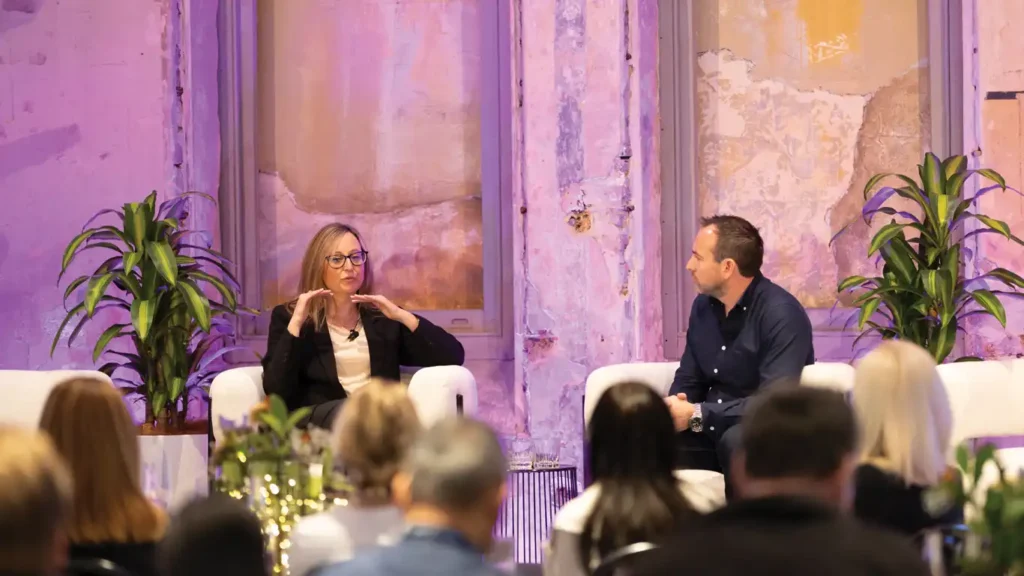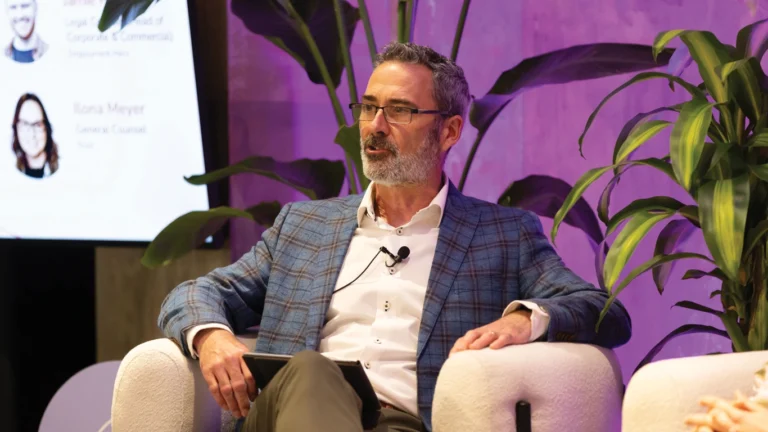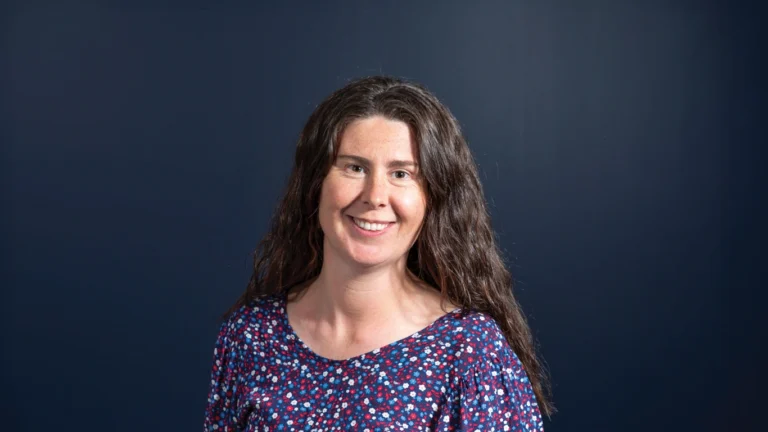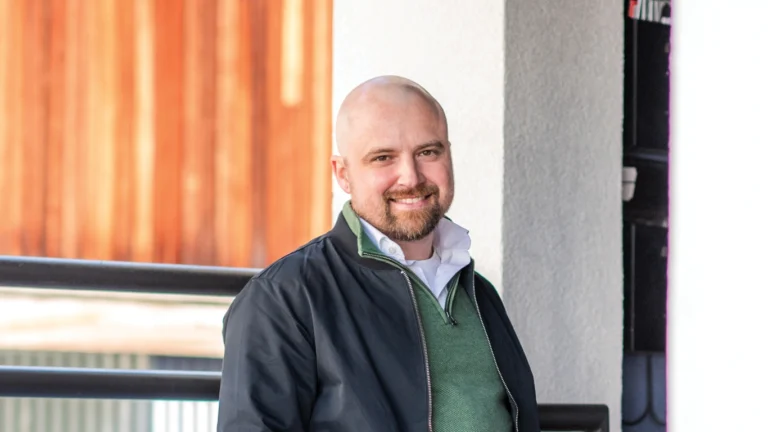
Joanna Brand, Commercial and Corporate Lawyer and Relationship Manager at Law Squared, on the value of authenticity
Trust and lawyers, Joanna says, should of course be natural bedfellows – but from a business’s perspective, lawyers are not always everyone’s favorite people, nor are they always intuitively trusted. This can make it difficult for an in-house legal function to truly become a strategic partner to the business.
The good news, though, is that trust is something that can be won, Joanna says. This can be achieved by being as transparent as possible with business colleagues (within the confines of business compliance and confidentiality), and by maintaining a consistent and calm demeanor. Even more important, she reminds us, is being a good listener. “If people feel you’re really hearing them, that helps to build trust. Part of listening is simply about being human – showing up as warm, empathetic, and collaborative.”
Joanna also emphasizes that, for in-house counsel, understanding your business is your business. Without an understanding of your organization’s key strategies, risks, and levers, offering meaningful advice is difficult.
“My philosophy has always been that I’m here to help the business deliver its strategic outcomes while appropriately managing risk. The word ‘appropriately’ carries a lot of weight, because what is appropriate changes across companies, business lifecycles, and industries. Understanding not only your organization’s strategy, but also its risk management appetite, is key to building trust, and should allow you to have influence and be a voice in the decision- making process.”
Shaun Plant, LawVu Legal Evangelist, on why tech is now an imperative for legal counsel

The type of work performed by today’s in-house lawyers bears little resemblance to that of their general counsel predecessors, says Shaun. The result: our influence at the decision-making table has become an opportunity denied. The in-house function has become a cog in the organizational wheel rather than one of its main drivers.
A reluctance to change ways of working has been a major cause of the gradual ‘demotion’ of in-house legal for our predecessors. “They lost contact with the changes that were happening in the business,” says Shaun. “The counsel they gave became outdated – it wasn’t meeting the needs of the organizations. Legal focused on legal issues and over time receded into more operational work. Which is where many of us continue to operate today.”
Shaun warns that if in-house legal doesn’t change, innovate, and adapt to the rapidly evolving business landscape, the profession will continue to fall further behind. “The in- house function of the future needs to embrace change and become trailblazers when it comes to innovation. Rather than pondering over the risks, we need to embrace technology and become accelerators for our businesses.”
For Shaun, the singular most significant transformation affecting today’s in-house legal profession is technology. By adopting processes that eliminate the need for the legal function to engage with low-value, repetitive work, lawyers will have the time to develop their business skills and expand their legal knowledge.
This will unlock far greater capacity for legal teams to deliver high-value, complex work. And when times get tough, and the volume of work is overwhelming, the processes and technology that have been put in place will make things far more manageable – and there will be less need to throw more lawyers at the problem.
Linda Robertson, GC and Director of Assurance at La Trobe University, on her experience of leading a team through a successful tech adoption
Melbourne’s La Trobe University has a large workforce of up to 5,000 employees, which includes many casuals, at any given time. Like many other similar institutions, it includes staff, researchers, students, third party partners all working, studying and living on its campuses making the university not just a tertiary institution, but a large and highly complex organization.
Five years ago, when Linda became GC, the legal function numbered just seven in comparison to today’s 13, and the challenge of managing a hefty workload using outdated tech systems was causing problems. “Team members were spending about 30 percent of their time working with insufficient systems which was, quite frankly, a nightmare. At times they were spending anything from half a day to an entire day just trying to keep up with the filing. I knew that if I could unlock even part of that inefficiency and give them back that time, we’d be able to work through matters faster and have the capacity to take on more high-value work.”
Bringing the team along on the journey was paramount, because there was a genuine but unfounded fear within the function that the introduction of a new platform would lead to job losses. And because she needed the capital to buy new technology, Linda also had to convince the university that making such an investment was the correct decision.
She knew that while the organization placed some value on the legal function, it wasn’t enough to put them at the strategic leadership table. And, just as importantly, over the years there’d been no impetus to invest in the team. “Whilst I don’t think it was ever said that the legal team was a cost center, that was the thought that permeated throughout the organization.”
Fortunately, Linda was able to get the green light to purchase a new platform, and over time she has also been able to increase her team’s headcount. “It was a strategic dance between legal and management,” she says. “The legal department is fantastic, and I wanted to grow the team in a sustainable way. I’m pleased to say that our tech investments really helped the business to recognize the value of their work, and we were able to successfully expand and move the dial from low value, low risk work to high value, high risk and strategically focussed work.”
When it came to implementing the team’s new software, Linda says that a staged approach paid off. “We prioritized our key clients before working with others. It took about nine months to complete the implementation across the whole university.” And because she had secured their buy-in early, there was no pushback from key stakeholders when it came to adoption. The result: LaTrobe’s legal team is getting to the table faster on big matters that are happening at the university, and the whole organization is feeling the value.

Sam Kidd, CEO at LawVu and InView, on why patience is key to systemic change
For Sam, the challenges that legal teams will have to grapple with in the near future are not just centered around the changes that come with the evolution of technology. Mindset and attitude, he says, are equally integral to our ability to navigate those changes – particularly when it comes to AI.
Sam likens the utilization of AI to taking out a gym membership: the purchase is the easiest and most painless part of the process. What follows is hard work, but eventually, weeks later, you break through. The pain lessens, the exercises become easier, and you are on your way to getting fitter and faster.
“It’s the process of slowing down to speed up which is the hardest part of change,” he says. “Whether it’s joining a gym or implementing new technology, it’s the fear of slowing down, having to hit pause for even a short time, which frightens people and the organizations they work for most.”
The world is on the cusp of a new industrial revolution, Sam says, and no matter your mindset or your attitude, technological advancements will happen.
“Change is both exciting and terrifying because it means stepping out of your comfort zone. As far as the legal industry is concerned, while outcomes will still be the same as they’ve always been, AI will remove the need for us to perform some of the individual tasks that we are all familiar and comfortable with.”
Sam closes with a reminder that, for in-house legal, the future of the profession is theirs to determine. But, ultimately, the decision-makers will be those who choose to embrace the technological changes that are already underway. “We are an important part of what the future is going to look like. Right now it’s about going on that journey with the right mindset and meeting change head-on.”
InView Connect 2025: Rise to the Moment is coming to London on May 15 and Sydney on September 18. Don’t miss out!


